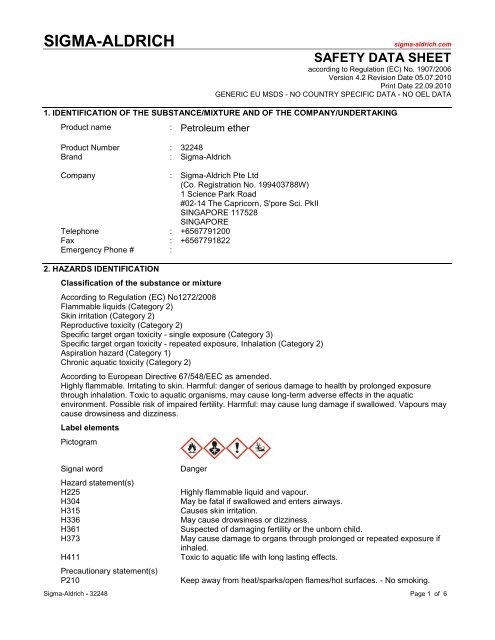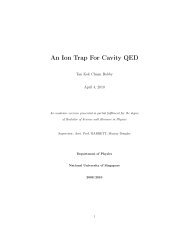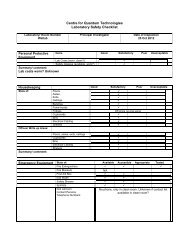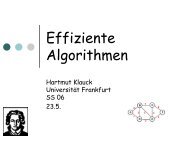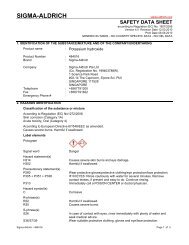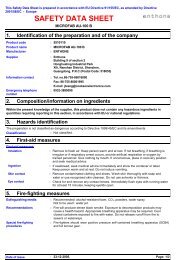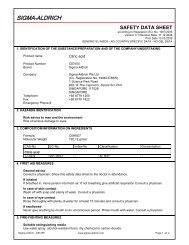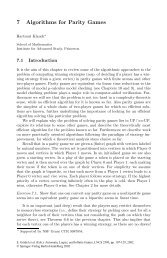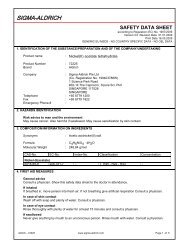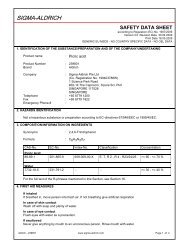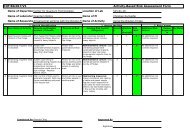You also want an ePaper? Increase the reach of your titles
YUMPU automatically turns print PDFs into web optimized ePapers that Google loves.
SIGMA-ALDRICHsigma-aldrich.comSAFETY DATA SHEETaccording to Regulation (EC) No. 1907/2006Version 4.2 Revision Date 05.07.2010Print Date 22.09.2010GENERIC EU MSDS - NO COUNTRY SPECIFIC DATA - NO OEL DATA1. IDENTIFICATION OF THE SUBSTANCE/MIXTURE AND OF THE COMPANY/UNDERTAKINGProduct name : <strong>Petroleum</strong> etherProduct Number : 32248Brand : Sigma-AldrichCompany : Sigma-Aldrich Pte Ltd(Co. Registration No. 199403788W)1 Science Park Road#02-14 The Capricorn, S'pore Sci. PkIISINGAPORE 117528SINGAPORETelephone : +6567791200Fax : +6567791822Emergency Phone # :2. HAZARDS IDENTIFICATIONClassification of the substance or mixtureAccording to Regulation (EC) No1272/2008Flammable liquids (Category 2)Skin irritation (Category 2)Reproductive toxicity (Category 2)Specific target organ toxicity - single exposure (Category 3)Specific target organ toxicity - repeated exposure, Inhalation (Category 2)Aspiration hazard (Category 1)Chronic aquatic toxicity (Category 2)According to European Directive 67/548/EEC as amended.Highly flammable. Irritating to skin. Harmful: danger of serious damage to health by prolonged exposurethrough inhalation. Toxic to aquatic organisms, may cause long-term adverse effects in the aquaticenvironment. Possible risk of impaired fertility. Harmful: may cause lung damage if swallowed. Vapours maycause drowsiness and dizziness.Label elementsPictogramSignal wordHazard statement(s)H225H304H315H336H361H373H411Precautionary statement(s)P210DangerHighly flammable liquid and vapour.May be fatal if swallowed and enters airways.Causes skin irritation.May cause drowsiness or dizziness.Suspected of damaging fertility or the unborn child.May cause damage to organs through prolonged or repeated exposure ifinhaled.Toxic to aquatic life with long lasting effects.Keep away from heat/sparks/open flames/hot surfaces. - No smoking.Sigma-Aldrich - 32248 Page 1 of 6
P261P273P281P301 + P310P331Hazard symbol(s)FXnNAvoid breathing dust/fume/gas/mist/vapours/spray.Avoid release to the environment.Use personal protective equipment as required.IF SWALLOWED: Immediately call a POISON CENTER ordoctor/physician.Do NOT induce vomiting.Highly flammableHarmfulDangerous for the environmentR-phrase(s)R11Highly flammable.R38Irritating to skin.R48/20 Harmful: danger of serious damage to health by prolonged exposurethrough inhalation.R51/53 Toxic to aquatic organisms, may cause long-term adverse effects in theaquatic environment.R62Possible risk of impaired fertility.R65Harmful: may cause lung damage if swallowed.R67Vapours may cause drowsiness and dizziness.S-phrase(s)S26S61S62Other hazards - none3. COMPOSITION/INFORMATION ON INGREDIENTSSynonyms : <strong>Petroleum</strong> benzinIn case of contact with eyes, rinse immediately with plenty of water andseek medical advice.Avoid release to the environment. Refer to special instructions/ Safety datasheets.If swallowed, do not induce vomiting: seek medical advice immediatelyand show this container or label.CAS-No. EC-No. Index-No. Classification Concentration<strong>Petroleum</strong> ether, Bp 40 - 70°C101316-46-5 309-852-0 - Flam. Liq. 2; Skin Irrit. 2;Repr. 2; STOT SE 3; STOTRE 2; Asp. Tox. 1; AquaticChronic 2; H225, H304,H315, H336, H361, H373,H411F, Xn, N, R11 - R38 - R48/20- R51/53 - R62 - R65 - R67For the full text of the H-Statements mentioned in this Section, see Section 16.-4. FIRST AID MEASURESGeneral adviceConsult a physician. Show this safety data sheet to the doctor in attendance.If inhaledIf breathed in, move person into fresh air. If not breathing give artificial respiration Consult a physician.In case of skin contactWash off with soap and plenty of water. Consult a physician.In case of eye contactRinse thoroughly with plenty of water for at least 15 minutes and consult a physician.Sigma-Aldrich - 32248 Page 2 of 6
If swallowedDo NOT induce vomiting. Never give anything by mouth to an unconscious person. Rinse mouth with water.Consult a physician.5. FIRE-FIGHTING MEASURESSuitable extinguishing mediaFor small (incipient) fires, use media such as "alcohol" foam, dry chemical, or carbon dioxide. For large fires,apply water from as far as possible. Use very large quantities (flooding) of water applied as a mist or spray;solid streams of water may be ineffective. Cool all affected containers with flooding quantities of water.Special protective equipment for fire-fightersWear self contained breathing apparatus for fire fighting if necessary.Further informationUse water spray to cool unopened containers.6. ACCIDENTAL RELEASE MEASURESPersonal precautionsUse personal protective equipment. Avoid breathing vapors, mist or gas. Ensure adequate ventilation.Remove all sources of ignition. Evacuate personnel to safe areas. Beware of vapours accumulating to formexplosive concentrations. Vapours can accumulate in low areas.Environmental precautionsPrevent further leakage or spillage if safe to do so. Do not let product enter drains. Discharge into theenvironment must be avoided.Methods and materials for containment and cleaning upContain spillage, and then collect with non-combustible absorbent material, (e.g. sand, earth, diatomaceousearth, vermiculite) and place in container for disposal according to local / national regulations (see section13).7. HANDLING AND STORAGEPrecautions for safe handlingAvoid contact with skin and eyes. Avoid inhalation of vapour or mist.Keep away from sources of ignition - No smoking. Take measures to prevent the build up of electrostaticcharge.Conditions for safe storageStore in cool place. Keep container tightly closed in a dry and well-ventilated place. Containers which areopened must be carefully resealed and kept upright to prevent leakage.8. EXPOSURE CONTROLS/PERSONAL PROTECTIONPersonal protective equipmentRespiratory protectionWhere risk assessment shows air-purifying respirators are appropriate use a full-face respirator withmulti-purpose combination (US) or type ABEK (EN 14387) respirator cartridges as a backup toengineering controls. If the respirator is the sole means of protection, use a full-face supplied airrespirator. Use respirators and components tested and approved under appropriate governmentstandards such as NIOSH (US) or CEN (EU).Hand protectionThe selected protective gloves have to satisfy the specifications of EU Directive 89/686/EEC and thestandard EN 374 derived from it.Handle with gloves.Eye protectionFace shield and safety glassesSkin and body protectionChoose body protection according to the amount and concentration of the dangerous substance at theSigma-Aldrich - 32248 Page 3 of 6
work place.Hygiene measuresHandle in accordance with good industrial hygiene and safety practice. Wash hands before breaks and atthe end of workday.9. PHYSICAL AND CHEMICAL PROPERTIESAppearanceFormColourSafety datapHMelting pointliquid, clearcolourlessno data availableno data availableBoiling point 60 - 80 °CFlash pointIgnition temperatureLower explosion limitUpper explosion limit-40,0 °C - closed cupno data availableno data availableno data availableDensity 0,66 - 0,68 g/mL at 20 °CWater solubilityno data available10. STABILITY AND REACTIVITYChemical stabilityStable under recommended storage conditions.Conditions to avoidHeat, flames and sparks.Materials to avoidStrong oxidizing agentsHazardous decomposition productsHazardous decomposition products formed under fire conditions. - Nature of decomposition products notknown.11. TOXICOLOGICAL INFORMATIONAcute toxicityno data availableSkin corrosion/irritationno data availableSerious eye damage/eye irritationno data availableRespiratory or skin sensitizationno data availableGerm cell mutagenicityno data availableCarcinogenicityIARC: No component of this product present at levels greater than or equal to 0.1% is identified asprobable, possible or confirmed human carcinogen by IARC.Sigma-Aldrich - 32248 Page 4 of 6
Reproductive toxicitySuspected human reproductive toxicantSpecific target organ toxicity - single exposureMay cause drowsiness or dizziness.Specific target organ toxicity - repeated exposureInhalation - May cause damage to organs through prolonged or repeated exposure.Aspiration hazardThe substance or mixture is known to cause human aspiration toxicity hazards or has to be regarded as if itcauses a human aspiration toxicity hazard.Potential health effectsInhalationIngestionSkinEyesSigns and Symptoms of ExposureCentral nervous system depressionAdditional InformationRTECS: no data available12. ECOLOGICAL INFORMATIONToxicityno data availablePersistence and degradabilityno data availableBioaccumulative potentialno data availableMobility in soilno data availablePBT and vPvB assessmentno data availableHarmful if inhaled. May cause respiratory tract irritation. Vapours may causedrowsiness and dizziness.May be harmful if swallowed. Aspiration hazard if swallowed - can enter lungsand cause damage.May be harmful if absorbed through skin. Causes skin irritation.May cause eye irritation.Other adverse effectsToxic to aquatic organisms, may cause long-term adverse effects in the aquatic environment.no data available13. DISPOSAL CONSIDERATIONSProductBurn in a chemical incinerator equipped with an afterburner and scrubber but exert extra care in igniting asthis material is highly flammable. Observe all federal, state, and local environmental regulations. Contact alicensed professional waste disposal service to dispose of this material.Contaminated packagingDispose of as unused product.14. TRANSPORT INFORMATIONADR/RIDUN-Number: 1268 Class: 3Packing group: IIProper shipping name: PETROLEUM DISTILLATES, N.O.S.IMDGSigma-Aldrich - 32248 Page 5 of 6
UN-Number: 1268 Class: 3 Packing group: II EMS-No: F-E, S-EProper shipping name: PETROLEUM DISTILLATES, N.O.S.Marine pollutant: NoIATAUN-Number: 1268 Class: 3Packing group: IIProper shipping name: <strong>Petroleum</strong> distillates, n.o.s.15. REGULATORY INFORMATIONThis safety datasheet complies with the requirements of Regulation (EC) No. 1907/2006.16. OTHER INFORMATIONText of H-code(s) and R-phrase(s) mentioned in Section 3Aquatic Chronic Chronic aquatic toxicityAsp. Tox. Aspiration hazardFlam. Liq. Flammable liquidsH225Highly flammable liquid and vapour.H304May be fatal if swallowed and enters airways.H315Causes skin irritation.H336May cause drowsiness or dizziness.H361Suspected of damaging fertility or the unborn child.H373May cause damage to organs through prolonged or repeated exposure if inhaled.H411Toxic to aquatic life with long lasting effects.Repr.Reproductive toxicitySkin Irrit. Skin irritationSTOT RE Specific target organ toxicity - repeated exposureFHighly flammableNDangerous for the environmentXnHarmfulR11Highly flammable.R38Irritating to skin.R48/20 Harmful: danger of serious damage to health by prolonged exposure throughinhalation.R51/53 Toxic to aquatic organisms, may cause long-term adverse effects in the aquaticenvironment.R62Possible risk of impaired fertility.R65Harmful: may cause lung damage if swallowed.R67Vapours may cause drowsiness and dizziness.Further informationCopyright 2010 Sigma-Aldrich Co. License granted to make unlimited paper copies for internal use only.The above information is believed to be correct but does not purport to be all inclusive and shall be usedonly as a guide. The information in this document is based on the present state of our knowledge and isapplicable to the product with regard to appropriate safety precautions. It does not represent any guaranteeof the properties of the product. Sigma-Aldrich Co., shall not be held liable for any damage resulting fromhandling or from contact with the above product. See reverse side of invoice or packing slip for additionalterms and conditions of sale.Sigma-Aldrich - 32248 Page 6 of 6


